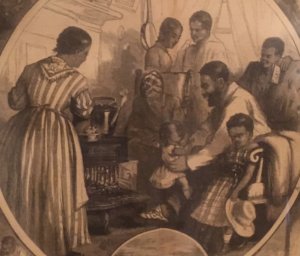
Detail of “the Future” from Thomas Nast’s drawing “Emancipation: The Emancipation of the Negroes, January 1865, The Past and the Future” published in Harper’s Weekly.
The Emancipation Proclamation issued by President Lincoln took effect on January 1, 1863. Nearly 200,000 Black men, many who were formerly enslaved, joined the Union army to personally fight for freedom.
George and Louisa’s grandson, Lindley Hoffman Miller (1834-1864) who begin serving in the U.S. Army after Lincoln’s call to arms in 1861, was appointed the Captain of the 1st Regiment of Arkansas Volunteers of African Descent in November 1863. An appointment that he sought out and was proud to hold. While serving with his unit, he wrote the words of the “Song of the First of Arkansas” to the tune of “John Brown” to inspire them. Here is an excerpt from the song:
“See, there above the center, where the flag is waving bright,
We are going out of slavery, we’re bound for freedom’s light;
We mean to show Jeff Davis how the Africans can fight,
As we go marching on!”
Imagine the emotions behind singing the words to this song, as the men in the regiment knew they were a part of changing America for the good and helping to save their families—their parents, brothers, sisters, wives, and children.
Resources:
Listen to two children’s stories from Guess & Go Story Time: The Listeners by Gloria Whelan and Ben and the Emancipation Proclamation by Pat Sherman:
https://business.facebook.com/maccullochhall/videos/120644286632603/
View the original Emancipation Proclamation preserved at the National Archives in Washington, D.C. https://www.archives.gov/exhibits/featured-documents/emancipation-proclamation
Topic: History, Thomas Nast
Age / Level: 1, Primary, Elementary

